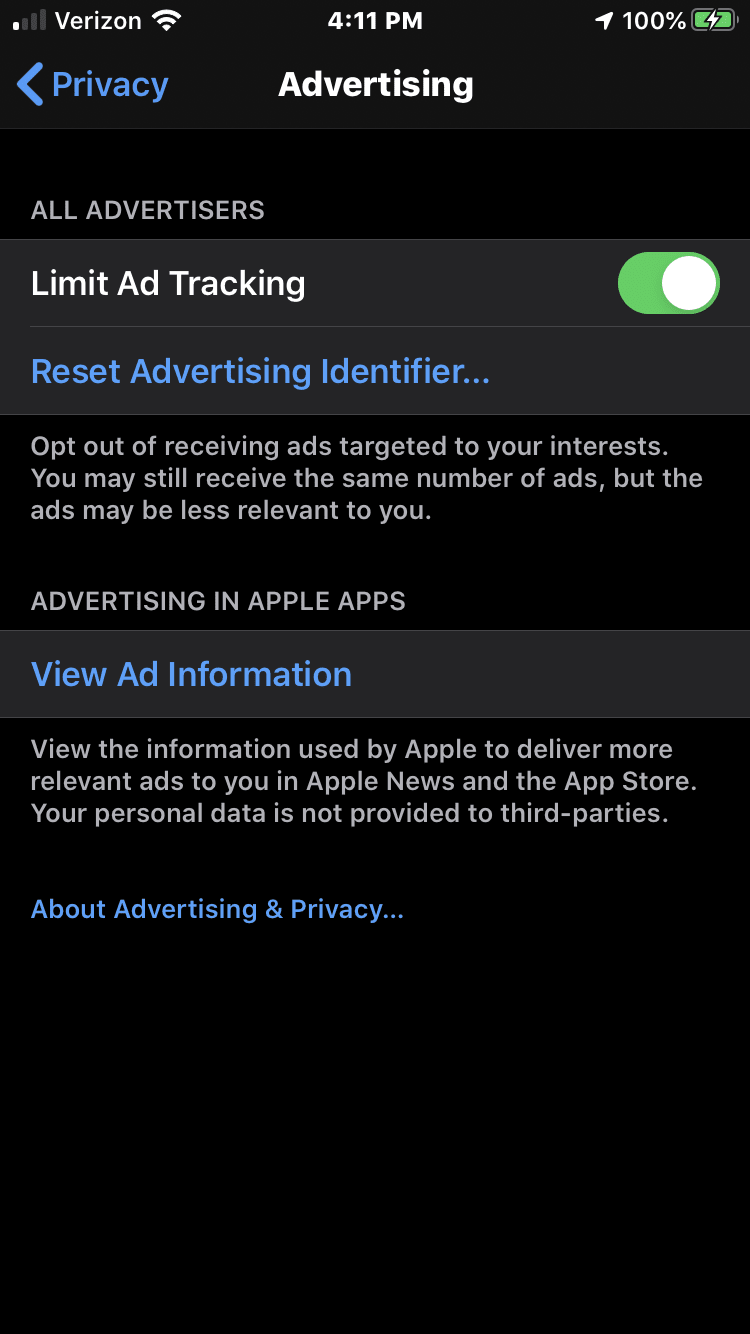This is the third of a series of posts regarding mobile marketing industry changes presented by iOS 14. Read the first article about the SKAdNetwork framework here. Read the second article about tracking conversions in SKAdNetwork here.
In my previous articles, I've talked about SKAdNetwork: what it is, how it is structured, and what data it provides. Now, I want to talk about the reason SKAdNetwork data is going to replace the IDFA: AppTrackingTransparency, the explicit opt-in to tracking that Apple will be implementing for all apps in 2021. To understand AppTrackingTransparency, it's important to first understand ad tracking in current iOS devices.
Limit Ad Tracking (LAT)
Currently, the IDFA can be deactivated by visiting the Settings app and going to Privacy > Advertising to enable the "Limit Ad Tracking" (LAT) switch. Note the auxiliary label that appears underneath it:
Opt out of receiving ads targeted to your interests. You may still receive the same number of ads, but the ads may be less relevant to you.
When a user chooses to turn on LAT, it masks their identifier for advertisers (IDFA), rendering them anonymous to mobile marketers. ~15.6% of iOS users had LAT turned on globally this year. The low adoption rate is likely influenced by it's buried location in the settings app, and even potentially due to the unbiased message provided by Apple. Since the majority of users don't activate LAT, the effects on the IDFA are still relatively minor; this, however, will all change with iOS 14.
LAT in iOS 14
Starting early 2021, Limit Ad Tracking will be on by default for all apps. There are several key differences in the behavior of LAT that come with this update:
- Instead of LAT being applied across all apps, it can now be turned on/off at the individual app level
- To turn LAT off, app developers must present a new dialogue to the user asking them for IDFA access. This is using the
requestTrackingAuthorization(completionHandler:)method - If a user chooses to keep LAT turned on, then the only data the advertiser can access from them is provided by
SKAdNetwork
This is an example of the dialogue that app developers need to make for users if they want to gain access to their data:
This dialog can only be presented once per app install. If the user does not allow tracking, there is no opportunity to present this again in the future for that app (unless the user deletes the app and reinstalls). After being presented with and denying access via this dialog, the only case where a user's IDFA could be made available again is through them manually turning off LAT for that app in the iPhone Settings.
The only customizable part of the dialog shown above is the secondary label that reads: "Your data will be used to deliver personalized ads to you." Developers can customize this part of the dialog by using the NSUserTrackingUsageDescription (documentation found here) to replace the default text with a message that informs the user why their app is requesting permission to use data for tracking the user or the device.
Conclusion
With LAT now on by default, the future of the IDFA depends on the percentage of users who choose to opt in. Some predict that only 10-20% of users will choose this option, with the remaining 80-90% opting to keep LAT turned on for their apps. Many apps also may choose not to provide this prompt to users at all, sacrificing IDFA access to preserve the user experience. Even advertisers whose apps choose to use AppTrackingTransparency must prepare to only receive a fraction of they data they can currently access.
Regardless of which route apps choose to follow, the current IDFA-dependent marketing and reporting strategies will need to change. Luckily, Xyla reporting has solutions for clients with or without MMPs, so you can get the performance data you need regardless of IDFA access. To learn more about Xyla offerings, click here.





Top comments (0)